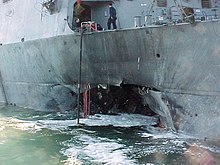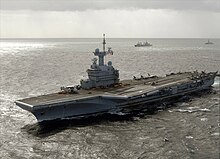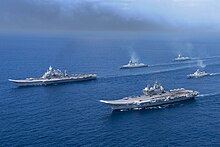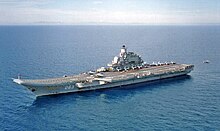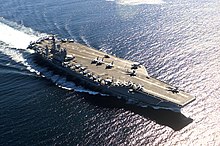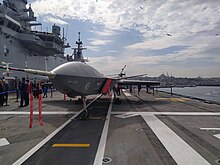Blue-water navy
A blue-water navy is a maritime force capable of operating globally, essentially across the deep waters of open oceans.
The Defense Counterintelligence and Security Agency of the United States has defined the blue-water navy as "a maritime force capable of sustained operation across the deep waters of open oceans.
"[2] In public discourse, blue-water capability is identified with the operation of capital ships such as battleships, battlecruisers, aircraft carriers, and nuclear submarines.
[6] While a blue-water navy can project sea control power into another nation's littoral waters, it remains susceptible to threats from less capable forces (asymmetric warfare).
Maintenance and logistics at range have high costs, and there might be a saturation advantage over a deployed force through the use of land-based air or surface-to-surface missile assets, diesel-electric submarines, or asymmetric tactics with fast attack craft (FAC).
A number of nations have extensive maritime assets but lack the capability to maintain the required sustainable logistic reach.
According to a dictionary definition, blue-water capability refers to an oceangoing fleet able to operate on the high seas far from its nation's home ports.
[10] In their 2012 publication, "Sea Power and the Asia-Pacific", professors Geoffrey Till and Patrick C. Bratton outlined what they termed as "concise criteria" with regard to the definitions of brown-, green- and blue-water navies.
[15] There have been many attempts by naval scholars and other authorities to classify world navies, including; Michael Morris,[17] British naval historians Eric Grove[17] and Professor Geoffrey Till,[17][18] French strategist Hervé Coutau-Bégarie[17][19] and professors Daniel Todd and Michael Lindberg.
[17][20][16] All identify basic common criteria for gauging the capability of navies, such as; total displacement and number of ships; modernity and power of weapons and systems; logistical and geographic reach with capacity for sustained operations; and the professional qualifications/disposition of sailors.
[17] The table below shows the world naval hierarchy according to the classification system by professors Daniel Todd and Michael Lindberg.
Naval Station Pearl Harbor acts as a "gateway" for the US Navy to "operate forward" in the Pacific Ocean.
Some have successfully used their blue-water capabilities to exercise control on the high seas and from there have projected power into other nations' littoral waters.
[29][31] In a 2013 report to Congress, defense experts also asserted that over the coming decades, China would gain the capability to project power across the globe – similar to Britain's 1982 Falklands War.
[29] In 2015, Todd and Lindberg's classification system put the PLAN was a rank four "regional power projection navy".
[36][37] This, according to Dr. George J. Gilboy and political scientist Eric Heginbotham, gives the Indian Navy the "leading power projection capability in the region".
[43][44] It also conducts routine two to three month-long deployments in the South and East China seas as well as the western Mediterranean simultaneously.
[56] It wasn't until 2007, under President Vladimir Putin, that "naval ambition broadened in scope and aimed at re-creating a large blue-water navy".
[66] As such, the Navy views the retention of its "world-class" high-end disciplines in anti-air and anti-submarine warfare as strategically important.
The United States Coast Guard, while not technically a navy, is also a blue-water naval force capable of deploying to waters throughout the world.
[15][70] While considered to be a green-water navy,[9] the Japan Maritime Self-Defense Force is undergoing transition to develop blue-water capabilities.
[79][80] It began in 1981 when Prime Minister Zenkō Suzuki put forward a new doctrine requiring the JMSDF to expand its operations by 1,000 miles for defense of the nation's sea lines of communication.
[81][82] The first Japanese post-WWII overseas naval air facility was established next to Djibouti-Ambouli International Airport; it supports a number of Lockheed P-3 Orion maritime patrol aircraft.
[86][87][88] In 2001, the South Korean President, Kim Dae-jung, announced plans to build a "Strategic Mobile Fleet".

